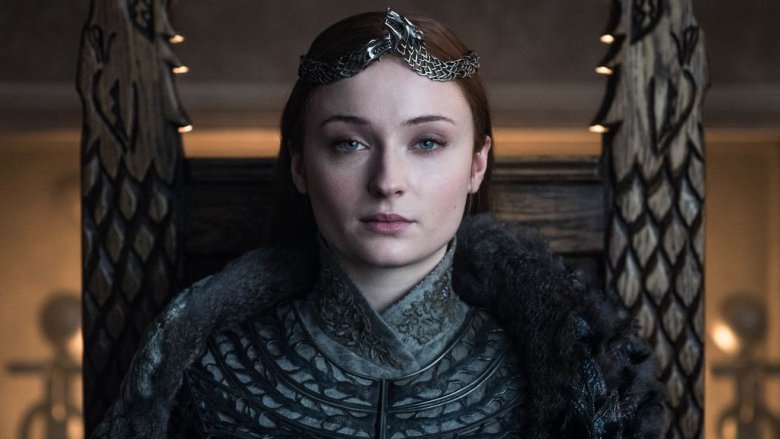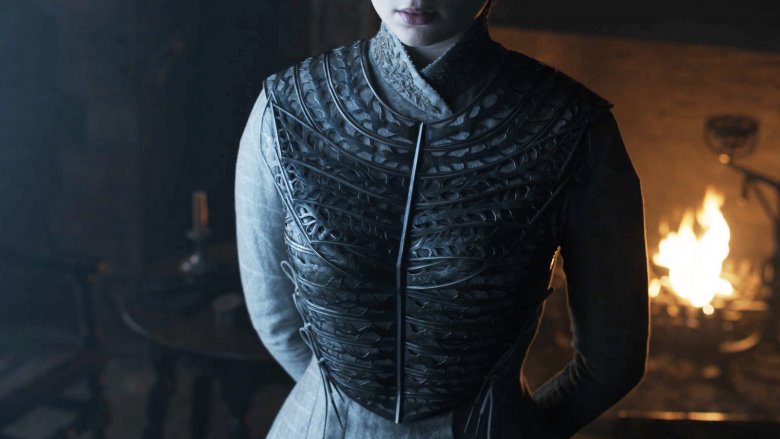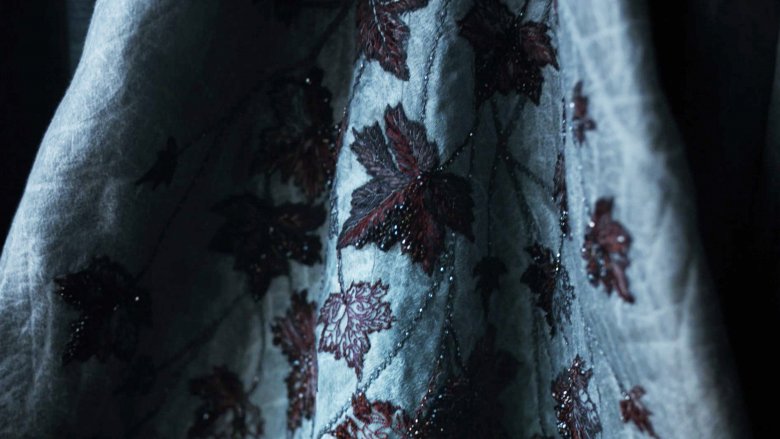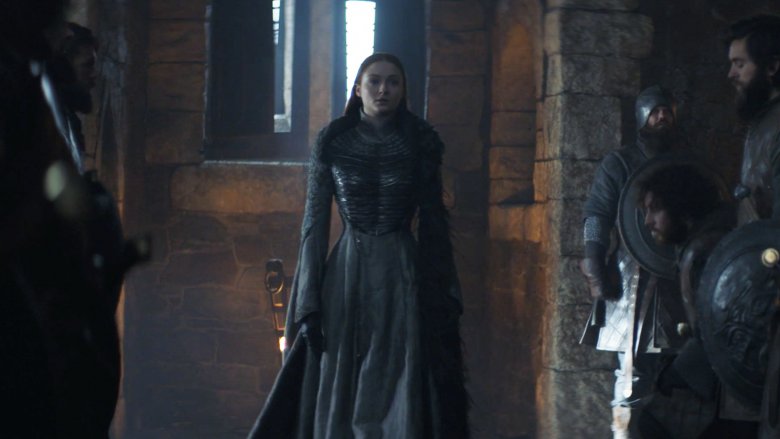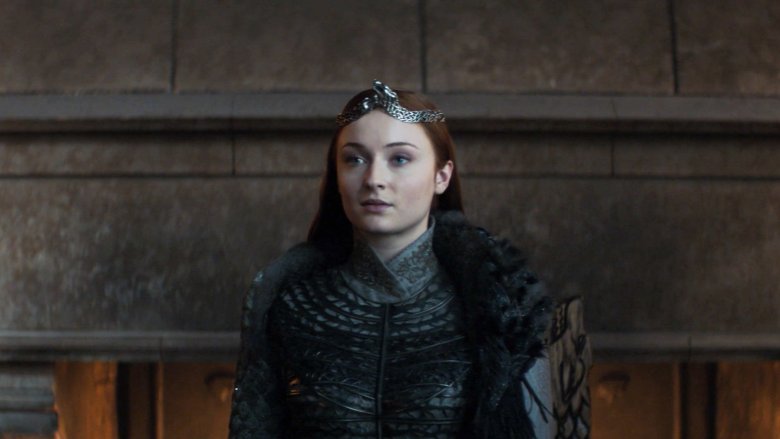The Hidden Meanings Behind Sansa's Final Game Of Thrones Look
Contains spoilers for the Game of Thrones series finale
Audiences have come to expect three big things from Game of Thrones: wild plot twists, a fair amount of bloodshed, and gorgeous costumes. Spoiler alert, but the finale included the characteristic trio — and placed an unexpected emphasis on the last of the three.
During the closing montage of the Game of Thrones finale, following the appointment of Bran "the Broken" Stark (Isaac Hempstead Wright) as the new protector of the Realm, viewers watched as Sansa Stark (Sophie Turner) prepared herself for her coronation as Queen in the North, now a completely separate kingdom with its own ruler. The little bird fans first met on season 1 came full circle in this moment, and the outfit she wore featured several tiny details that paid homage to her incredible journey.
Here are all the hidden meanings behind Sansa's final Game of Thrones look.
The first nod to Sansa's evolution from a meek girl wanting to marry Joffrey Baratheon (Jack Gleeson) to an independent woman who would do anything to protect her family is found in her intricate chest plate. Game of Thrones costume designer Michele Clapton explained that the bodice features "the growing branches of the weirwood tree" — the tree important to the Stark family, found in the godswood of Winterfell.
Within the series, plenty of pivotal moments happen beneath the weirwood tree: Night's Watch recruits making their vows, Jon Snow (Kit Harington) reuniting with Arya (Maisie Williams), the Starks learning that Jon is actually a Targaryen, and Arya killing the Night King once and for all. The weirwood tree, which grows only in the North, is a place of worship for House Stark; that Sansa's coronation dress features its branches is quite special. The chest plate itself is also significant in that it shows a softer side of Sansa: she's sported armor before, but this is more delicate, worn for peace and not war.
Speaking of the weirwood tree, one of the two belled sleeves of Sansa's dress is embroidered with deep red, five-pointed leaves — the same ones found on the sacred tree. In the novels written by George R.R. Martin, weirwood trees are said to live forever if they are properly cared for and left undisturbed. This is seemingly what Sansa intends to do with the North: preserve it so that it may never fall.
Not only do the leaves on Sansa's costume honor House Stark, provide a drastic contrast to her younger self who desperately wanted to be a Southern queen and not a Northern girl, and show that she is finally in the exact place she was meant to be, but they also link to her brother's recent inauguration as King of Westeros and to the attitude of the North as a whole. Tyrion Lannister (Peter Dinklage) lobbied for Bran to become king on the basis that he possesses infinite knowledge and has a powerful origin story. In Martin's novel A Dance with Dragons, Jojen Reed tells Bran that the original inhabitants of Westeros, the Children of the Forest, had "no ink, no parchment, no written language" — only the trees and the weirwoods. When the Children died, "the trees remembered." Sounds a lot like the favorite House Stark phrase "the North remembers," no?
The sleeves themselves are symbolic as well, as they and Sansa's entire dress are made from the same fabric as two other iconic Game of Thrones outfits. Clapton revealed that she utilized for Sansa's finale costume the fabric of the "dark Sansa dress," seen on the eighth episode of the fourth season when Sansa unveiled her mysterious new look to Littlefinger (Aidan Gillen). That dress was made using the fabric of the costume Margaery Tyrell (Natalie Dormer) wore when she married Joffrey. When she lived in King's Landing, Sansa went to great lengths to blend in with and emulate the Southern women around her, and took a particular interest in Margaery, who tried to help Sansa escape the Lannisters' viciousness. As Clapton explained, "Sansa had a bond with her."
Many have pointed out that the pattern of the fabric also looks like fish scales — which would be a nod to the silver trout sigil of House Tully. Sansa's mother, Catelyn (Michelle Fairley), was a Tully before she married Ned Stark (Sean Bean). Catelyn was brutally murdered during the Red Wedding, at the hands of the Freys but the command of the Lannisters. Though Clapton didn't mention anything about the fabric honoring Catelyn's memory, it's not implausible to think that Sansa selected the fabric for that very reason.
Moving up, Sansa wears a feathered, embroidered direwolf stole around her neck and across her shoulder as a tribute to House Stark. Clapton noted that Sansa's sleeves are textured with the same feathers and fur as the stole.
To top everything off is Sansa's crown, an intricate ring that meets in the middle to show two direwolves howling. The crown symbolizes Sansa's dedication to her family and to the North, and even looks similar to the crown Cersei Lannister (Lena Headey) wore in her later years when she sat on the Iron Throne. Sansa's former sister-in-law through her marriage to Tyrion, Cersei taught the Stark girl many lessons — not the least of which regarded what not to do when you rise to power.
The crown rests atop Sansa's fiery hair, worn down and without any braids or twists. Her hair in this final look sends an impactful message about what she's been through and where she intends to go.
All throughout her life, Sansa has worn her hair in styles of varying complexity, each of which was meant to mimic the people whom she wanted to be like. Sansa's humble braids during the first few episodes of Game of Thrones showed that she was a Northern girl; her wild up-dos during her years at King's Landing emulated Cersei Lannister's styles; her soft twists thereafter mirrored those of Margaery Tyrell's preferred hairdo; her pulled-back braids reflected the style her late mother used to wear; and the heavily braided styles seen on the later episodes of the series evoked the 'dos Daenerys Targaryen (Emilia Clarke) wore, with each braid indicating a battle won.
Wearing her hair loose and unadorned shows that Sansa isn't trying to be anyone else other than herself, and a few fans have even drawn parallels between Sansa's coronation hair and that of real-life queen Elizabeth I. Both women faced abuse throughout their lives, and both opted for coronation hairstyles that held deep significance.
Cultural critic and expert on Renaissance literature Anthony Oliveira tweeted upon seeing Sansa during her coronation, "Sansa's hair completely down (vs complicated looks of her youth & severe pinbacks of Winterfell stewardship) took my breath away. Elizabeth wore hers down at her coronation to signal sexual purity, in open hostility to those who said her sexual abuse ruined her."
He later added in an interview with Vox that Sansa "learned the same lessons as Elizabeth" and the two women channeled their changing power through their physical appearance.
"When it's time for [Elizabeth's] coronation, she wears her hair down, which is a big, big deal," said Oliveira. "It signals her virginity: to be unadorned for her, is the ultimate adornment. It says, 'Screw all of you, I'm in no way sexually complicit or guilty.' Sansa's silhouette is identical: the long, flowing hair and the tight hourglass ... [The showrunners] have been building this throughout: Sansa is a seamstress, she loves embroidery, she's learned how to be image-conscious. That was Elizabeth's game."
Like costume designer Michele Clapton said, "nothing is created without meaning." Every aspect of Sansa's finale look was significant, and they all came together to create a lasting image of the person she was destined to become. The aspiring Queen of Westeros is now the Queen in the North — and long may she reign.
